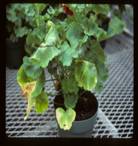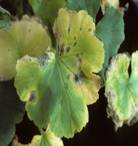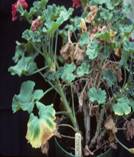Introduction
Florist's Geranium ( Pelargonium x hortorum L. H. Bailey) sre susceptible to three bacterial diseases that cause leaf spots, wilt, or both these symptoms. Xanthomonas campestris pv . pelargonii is the most destructive disease of florist's geranium; ivy and seed geraniums are also susceptible. This disease has been referred to as bacterial stem rot, bacterial wilt, bacterial leaf spot, and bacterial blight. In spite of widespread use of culture-indexing techniques and clean plant programs, this disease still appears from time to time and can cause a serious problem for growers. Pseudomonas species, including P. cichorii and P. syringae pv. syringae, cause leaf spot diseases on a wide range of flowering potted plants. Southern bacterial wilt caused by Ralstonia solanacearum Race 3, Biovar 2 is a serious disease of both geraniums and vegetables in the Solanaceae and is under federal quarantine due to the threat to agricultural crops.
Xanthomonas campestris pv . pelargoni

Pseudomonas cichorii

Ralstonia solanacearum

Contact the UMass Extension Plant Diagnostic Lab at (413) 545-3208.
Management of Bacterial Diseases
Strict adherence to good sanitation practices is essential to the management of bacterial diseases. There are no pesticide sprays or drenches that will cure plants or provide total protection from bacterial diseases.
- Symptomatic plants should be discarded.
- Diseased plant debris should be promptly removed from the growing area.
- Workers should wash their hands frequently and immediately after handling infected plants or soil.
- Splashing from irrigation water should be minimized.
- Minimize leaf wetness by watering early in the day or sub-irrigating.
- Avoid handling plants when they are wet.
- Nutrition may affect disease susceptibility; avoid excess or insufficient fertilization.
- Culture index stock plants or purchase of plants from a reputable source.
- Tools should disinfected frequently.
- Do not re-use growing medium.
- Do not hang ivy baskets over seed or zonal geraniums.
- As much as possible, separate seed geraniums from vegetative cuttings. Plants from different propagators should be separated.
- Bactericides such as copper hydroxide and copper sulfate pentahydrate are only marginally effective in controlling bacterial diseases.
References
- Photo Library: Diseases
- Field Guide to Diseases of Greenhouse Ornamentals. 1993. Daughtrey, M. L. and Chase, A. R. Ball Publishing, Chicago , IL 224 pp.
- Compendium of Flowering Potted Plant Diseases. 1995. Daughtrey, M. L., Wick, R. L. and Peterson, J. L. APS Press, St. Paul, MN. 90 pp.
- Diseases and Pests of Ornamental Plants, 5th ed. 1978. Pirone, P. P. Wiley-Interscience Publication, New York , NY 566 pp.
- Diseases of Annuals and Perennials . 1995. Chase, A. R., Daughtrey, M. and Simone, G. W. Ball Publishing Co., Batavia , IL . 202 pp.
- Diseases of Floral Crops, Volume 1 and 2. 1985. Strider, D. L. Praeger, New York , NY 638 and 579 pp.
- Geraniums IV. 1993. White, J. W. Ball Publishing, Geneva , Illinois . 412 pp.
Video - Diagnosing Bacterial Wilt Diseases
This movie was made by Dr. Rob Wick, Plant Pathologist at UMass Amherst during a diagnostic plant pathology workshop in Bangladesh. To demonstrate bacterial streaming, Rob used a tomato plant that had a vascular bacterial infection (Ralstonia solanacearum). A stem about 3 inches long is suspended in a glass of water using a paper clip. The paper clip is straightened and pierced through the stem and perched on the top of the glass. To see streaming, a dark background is placed behind the glass and illuminated with side lighting. Once set up, do not disturb; the bacterial will come out in seconds. The bacteria produce a sticky matrix which helps protect them, and allows the bacterial strands to remain intact as they fall through the water. Note the "pools" of bacteria forming in the bottom of the glass. This same sticky mess clogs up the water conducting cells of the plant resulting in wilt. This technique will work with Clavibacter, Xanthomonas and Ralstonia vascular infections. The type of plant does not matter, so will also work with a geranium leaf.




0 comments
إرسال تعليق